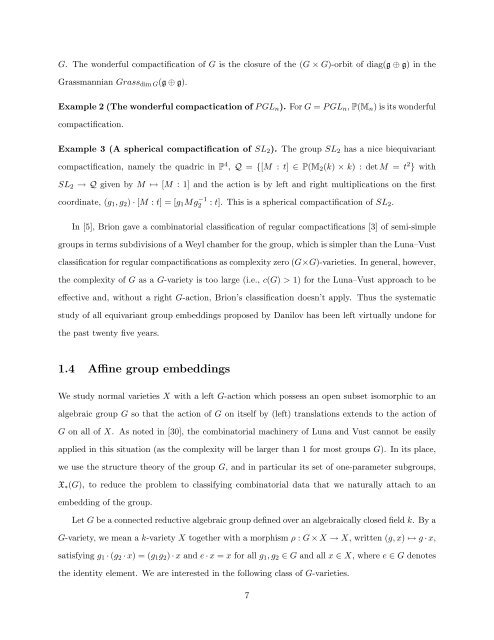Equivariant Embeddings of Algebraic Groups
Equivariant Embeddings of Algebraic Groups
Equivariant Embeddings of Algebraic Groups
Create successful ePaper yourself
Turn your PDF publications into a flip-book with our unique Google optimized e-Paper software.
G. The wonderful compactification <strong>of</strong> G is the closure <strong>of</strong> the (G × G)-orbit <strong>of</strong> diag(g ⊕ g) in the<br />
Grassmannian Grass dim G (g ⊕ g).<br />
Example 2 (The wonderful compactication <strong>of</strong> P GL n ). For G = P GL n , P(M n ) is its wonderful<br />
compactification.<br />
Example 3 (A spherical compactification <strong>of</strong> SL 2 ). The group SL 2 has a nice biequivariant<br />
compactification, namely the quadric in P 4 , Q = {[M : t] ∈ P(M 2 (k) × k) : det M = t 2 } with<br />
SL 2 → Q given by M ↦→ [M : 1] and the action is by left and right multiplications on the first<br />
coordinate, (g 1 , g 2 ) · [M : t] = [g 1 Mg −1<br />
2 : t]. This is a spherical compactification <strong>of</strong> SL 2 .<br />
In [5], Brion gave a combinatorial classification <strong>of</strong> regular compactifications [3] <strong>of</strong> semi-simple<br />
groups in terms subdivisions <strong>of</strong> a Weyl chamber for the group, which is simpler than the Luna–Vust<br />
classification for regular compactifications as complexity zero (G×G)-varieties. In general, however,<br />
the complexity <strong>of</strong> G as a G-variety is too large (i.e., c(G) > 1) for the Luna–Vust approach to be<br />
effective and, without a right G-action, Brion’s classification doesn’t apply. Thus the systematic<br />
study <strong>of</strong> all equivariant group embeddings proposed by Danilov has been left virtually undone for<br />
the past twenty five years.<br />
1.4 Affine group embeddings<br />
We study normal varieties X with a left G-action which possess an open subset isomorphic to an<br />
algebraic group G so that the action <strong>of</strong> G on itself by (left) translations extends to the action <strong>of</strong><br />
G on all <strong>of</strong> X. As noted in [30], the combinatorial machinery <strong>of</strong> Luna and Vust cannot be easily<br />
applied in this situation (as the complexity will be larger than 1 for most groups G). In its place,<br />
we use the structure theory <strong>of</strong> the group G, and in particular its set <strong>of</strong> one-parameter subgroups,<br />
X ∗ (G), to reduce the problem to classifying combinatorial data that we naturally attach to an<br />
embedding <strong>of</strong> the group.<br />
Let G be a connected reductive algebraic group defined over an algebraically closed field k. By a<br />
G-variety, we mean a k-variety X together with a morphism ρ : G × X → X, written (g, x) ↦→ g · x,<br />
satisfying g 1 · (g 2 · x) = (g 1 g 2 ) · x and e · x = x for all g 1 , g 2 ∈ G and all x ∈ X, where e ∈ G denotes<br />
the identity element. We are interested in the following class <strong>of</strong> G-varieties.<br />
7
















